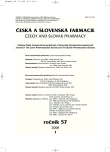Antioxidant activity of tinctures prepared from hawthorn fruits and motherwort herb
Authors:
R. Masteiková 1; J. Muselík 1; J. Bernatonienė 2; D. Majienė 2,3; A. Savickas 2; F. Malinauskas 4; R. Bernatonienė 4; R. Pečiūra 2; Z. Chalupová 1; K. Dvořáčková 1
Authors‘ workplace:
Veterinární a farmaceutická univerzita Brno, Farmaceutická fakulta, Ústav technologie léků
1; Kaunasská univerzita medicíny, Farmaceutická fakulta, Katedra technologie léků a sociální farmacie, Litva
2; Kaunasská univerzita medicíny, Institut biomedicínského výzkumu, Litva
3; Kaunasská univerzita medicíny, Farmaceutická fakulta, Katedra farmaceutické chemie a farmakognozie, Litva
4
Published in:
Čes. slov. Farm., 2008; 57, 35-38
Category:
Original Articles
Overview
The paper aimed to determine and compare the antioxidant activity of two tinctures and selected flavonoids present in the tinctures. The tinctures were prepared from hawthorn fruits and motherwort herb. The group of selected flavonoids included rutin, quercetin, hyperosid, epicatechine, and procyanidin B2. Two methods were employed to determine antioxidant activities: the inhibition of peroxynitrite-induced nitration of tyrosine was measured, and the ability to quench radicals was examined by of the stable radical 2,2-diphenyl-1-picrylhydrazyl (DPPH). Both tinctures under study were able to quench radicals and reactive forms of oxygen and nitrogen. The motherwort herb tincture was more effective, but no direct effect of phenolic compounds on the extent of antioxidant activity was demonstrated. The total content of polyphenols in the motherwort herb tincture was higher by 163 %, nevertheless antiperoxynitrite activity was higher just by 19 % (p < 0.05), and the ability to reduce DPPH differed in both tinctures in a minimal manner. Of the individual flavonoids, the substances present in the tinctures in higher concentrations contributed most to antioxidant activity. In the hawthorn fruit tincture it was epicatechine and hyperosid, whereas in the motherwort herb tincture it was rutin.
Key words:
Crataegi fructus – Leonuri herba – tinctures – flavonoids – antioxidant activity
Sources
1. Halliwell, B. et al.: Food Chem. Toxicol., 1995; 33(7), 601–617.
2. Citog-lu, G. S. et al.: J. Ethnopharmacol., 2004; 92, 275–280.
3. Cai, Y. et al.: Life Sci., 2004; 74, 2157–2184.
4. El Naggar, E. B. et al.: Acta Vet. Brno, 2005; 74, 347–352.
5. Simone, C. B. et al.: J. Alter. Ther. Health Med., 2007, 13(1), 22–28.
6. Balaraman, R., Bafna, P. A., Kolhapure, S. A.: J. Ethnopharmacol., 2004; 94, 135–141.
7. Vetchý, D., Ceral, J.: Neurologie pro praxi, 2005; 4, 218–220.
8. Pieta, P.-G. J.: Nat. Prod., 2000; 63, 1035–1042.
9. Kolečkář, V. et al.: Čes. slov. Farm., 2007; 56, 73–76.
10. Cornelli, U. et al.: J. Nutr., 2001; 131, 3208–3211.
11. Aguay, D. et al.: Burns, 2005; 31(3), 366–371.
12. Rigelsky, J. M., Sečet, B. V.: Am. J. Health Syst. Pharm., 2002, 59, 417–422.
13. Daniele, C. et al.: Drug safety, 2006, 29(6), 523–535.
14. WHO monograph of selected medicinal plants. Vol. 2. Ženeva, WHO, 2001, s. 66.
15. Vierling, W. et al.: Phytomedicine, 2003; 10, 8–16.
16. Zhang, Z. Z. et al.: J. Nutr. Biochem., 2001; 12, 144–152.
17. Yoo, K. M. et al.: Food Chem., 2008, 106, 929–936.
18. Milkowska-Leyck, K., Filipek, B., Strzelecka, H. J.: Ethnopharmacol., 2002; 80, 85–90.
19. Ali, M. S. et al.: Phytother. Res., 2007; 21, 558–561.
20. Matkowski, A., Piotrowska, M.: Fitoterapia, 2006, 77, 346–353.
21. Muselík, J., Hytych, P., Žemlička, M.: Čes. slov. Farm., 2005; 54, 114–117.
22. Merken, H. M., Beecher, G. R.: J. Agric. Food Chem., 2000; 48, 577–599.
23. Middleton, E., Kandaswami, C.: Biochem.Pharmacol., 1992; 43(6), 1167–1179.
24. Muselík, J. et al.: Int. J. Mol. Sci., 2007; 8, 797–809.
25. Lee, J. Y., Hwang, W.-I., Lim, S.-T.: J. Ethnopharmacol., 2004; 93, 409–415.
26. Huang, A., Ou, B., Prior, R. L.: J. Agric. Food Chem., 2005; 53, 1841–1856.
27. Pellati, F. et al.: J. Pharm. Biomed. Anal., 2004; 35, 289–301.
28. Fenglin, H. et al.: Fitoterapia, 2004; 75, 14–23.
29. Bozan, B., Karakaplan, U.: Acta Aliment., 2007; 36 (3), 321–328.
30. Masteiková, R. et al.: Medicina, 2007; 43(4), 306–309.
31. Soobrattee, M. A. et al.: Mutation Res., 2005; 579, 200–213.
32. Havsteen, B. H.: Pharmacol. Ther., 2002; 96(2–3), 67–202.
33. Lee, K. W., Lee, H. J.: Biofactors, 2006; 26(2), 105–121.
Labels
Pharmacy Clinical pharmacologyArticle was published in
Czech and Slovak Pharmacy

2008 Issue 1
Most read in this issue
- Signal pathways of cell proliferation and death as targets of potential chemotherapeutics
- Hemostatic effects of oxidized cellulose
- Substances Modifying the Activity of Caspases
- Antioxidant activity of tinctures prepared from hawthorn fruits and motherwort herb
